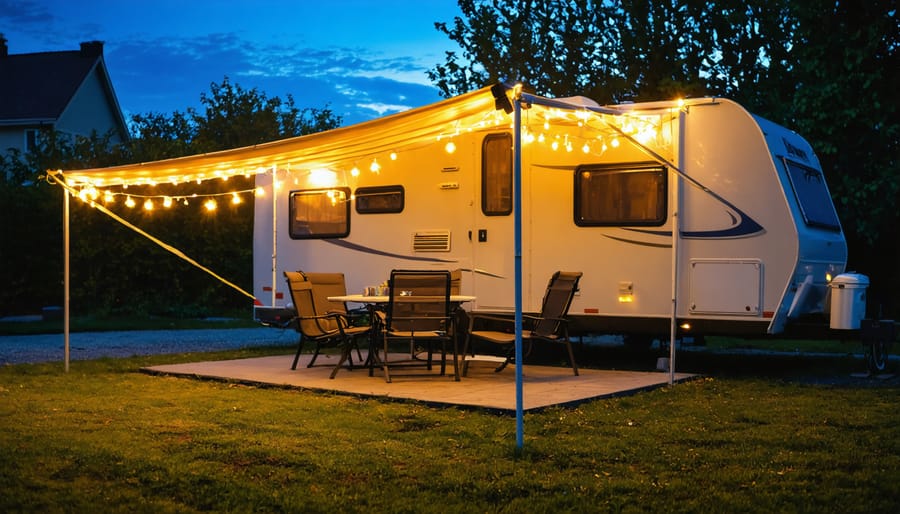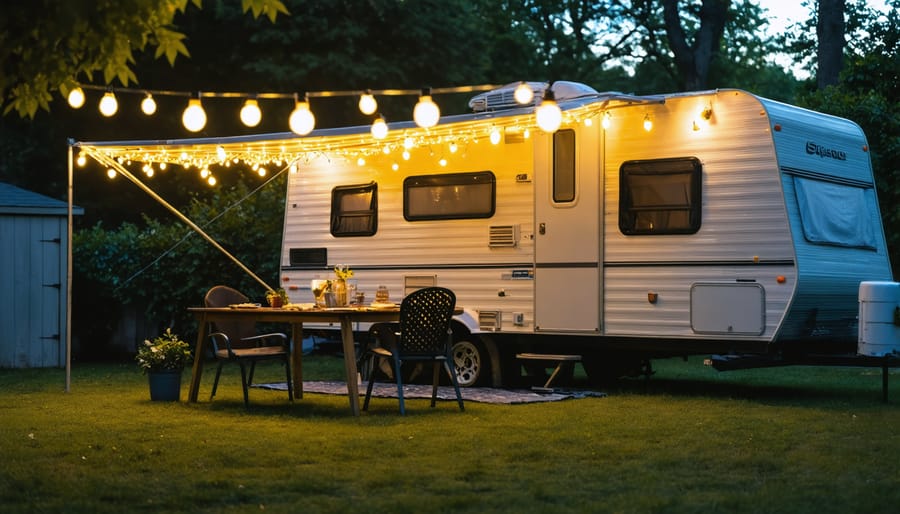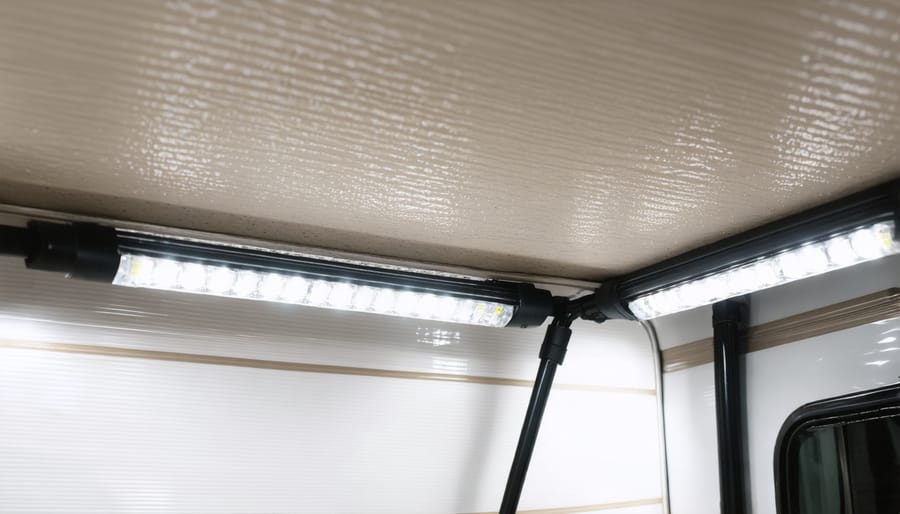Transform Your RV’s Outdoor Space with Smart Lighting That Works

Transform your RV’s exterior into a welcoming oasis with strategic outdoor lighting ideas that combine functionality and style. Install weatherproof LED strip lights under your RV’s awning to create an instant outdoor living space, while consuming minimal power from your battery. Mount motion-sensor security lights near entry points and storage compartments for enhanced safety and convenience during nighttime activities. Position solar-powered pathway lights leading to your campsite’s amenities, eliminating trip hazards while adding ambient charm to your outdoor setup. Today’s RV lighting solutions offer unprecedented flexibility – from color-changing smart bulbs that sync with your phone to ultra-efficient battery-operated options that last entire camping seasons. Whether you’re a weekend warrior or full-time RVer, proper outdoor lighting transforms your campsite into a cozy, secure home base while maximizing energy efficiency and minimizing installation complexity.
Essential RV Exterior Lighting Zones
Entryway and Step Lighting
Proper entryway lighting is crucial for safe RV access during nighttime hours. Install motion-sensor LED strips along your steps to automatically illuminate when someone approaches, preventing accidents and stumbles. Consider adding recessed lights under your RV’s awning or beside the door for consistent illumination of the entrance area. Weather-resistant path lights leading to your steps create an inviting walkway while improving visibility. For added safety, mount a bright porch light above your RV door that can be controlled from both inside and outside. Battery-operated stick-on lights are perfect for illuminating individual steps, and they’re easy to install without any wiring. Remember to position lights to minimize glare while maximizing visibility of potential trip hazards.
Awning and Patio Space
Transform your RV’s awning area into a cozy outdoor living space with strategic lighting choices. Start by installing LED strip lights along the awning rail for consistent overhead illumination. These energy-efficient strips create a warm ambiance perfect for evening gatherings. Add portable battery-operated lanterns or flameless candles on tables for intimate lighting that’s easy to adjust.
Consider mounting weatherproof sconce lights on your RV’s exterior wall beneath the awning for focused task lighting. String lights zigzagged across the awning space add a festive touch while providing gentle illumination for dining or socializing. For added functionality, use magnetic battery-operated puck lights under the awning – they’re easy to install and remove as needed.
Don’t forget about pathway lighting leading to your outdoor space. Solar stake lights along the edges of your patio mat create safe navigation while adding to the overall ambiance.

Storage Bay and Utility Areas
Illuminate your RV’s storage compartments and utility areas with practical lighting solutions that enhance functionality and safety. Install motion-sensor LED strip lights along compartment doors to automatically brighten when opened, making it easier to locate items at night. Weather-resistant puck lights mounted inside storage bays provide focused illumination for deeper compartments. Consider adding magnetic battery-operated lights for flexible placement options. For utility areas like water hookups and dump stations, weatherproof flood lights with wide-angle beams ensure clear visibility during nighttime maintenance. Install switch-activated LED markers near critical connection points to quickly identify them in low-light conditions. Remember to choose moisture-resistant fixtures rated for outdoor use to ensure longevity in these exposed areas.
Smart Lighting Solutions for Your RV
Solar-Powered Options
Solar-powered lighting offers one of the most practical and energy-efficient outdoor solutions for RV enthusiasts. These lights harness the sun’s energy during the day and automatically illuminate your outdoor space at night, making them perfect for boondocking or campsites without electrical hookups.
Popular solar options include string lights, which create a warm, inviting ambiance around your awning or campsite perimeter. Look for weatherproof models with durable LED bulbs that can withstand various weather conditions. Motion-sensor solar lights are another excellent choice, providing security while conserving energy by activating only when needed.
Path lights and stake lights powered by solar panels are perfect for marking walkways and creating safe passage around your RV at night. Many modern versions come with adjustable brightness settings and can last up to 8-12 hours on a full charge.
For maximum efficiency, position solar panels where they receive direct sunlight during peak hours. Clean the panels periodically to ensure optimal charging, and consider purchasing lights with backup battery options for cloudy days. Some newer models even include USB charging capabilities as a backup power source, ensuring you’re never left in the dark.
Remember to look for lights with warm white LEDs (2700-3000K) rather than cool white, as these create a more comfortable and welcoming atmosphere around your RV while being gentle on the eyes.

LED Strip and String Lights
LED strips and string lights offer some of the most versatile creative lighting solutions for your RV’s exterior. These flexible lighting options can be installed along awnings, under storage compartments, or around doorways to create both practical illumination and welcoming ambiance.
For awning lighting, opt for waterproof LED strips with warm white lights that provide gentle, even illumination perfect for evening gatherings. Many modern LED strips come with remote controls and color-changing capabilities, allowing you to adjust the mood from relaxing white light to festive colors for special occasions.
String lights are particularly popular among RV enthusiasts for their charm and ease of installation. Choose commercial-grade outdoor string lights with durable weatherproof bulbs that can withstand travel and various weather conditions. These can be hung along your awning’s edge or strung between your RV and nearby trees to create a cozy outdoor living space.
When installing LED strips, use proper mounting clips and weatherproof adhesive designed for exterior use. For string lights, consider installing permanent hooks or clips that won’t damage your RV’s exterior but provide secure attachment points. Both lighting options are energy-efficient, typically drawing minimal power from your RV’s battery system, making them practical for extended camping trips.
Motion-Activated Security Lights
Motion-activated security lights are a game-changer for RV safety, offering both convenience and peace of mind during your camping adventures. These smart fixtures automatically illuminate when they detect movement, creating a protective barrier around your RV while conserving energy when not needed.
For optimal coverage, install motion sensors at key points around your RV: near the entry door, storage compartments, and along walkways. Most modern motion-activated lights offer adjustable sensitivity settings, allowing you to fine-tune their response to prevent false triggers from small animals or swaying branches.
Many RVers prefer LED motion lights because they’re energy-efficient and provide bright, reliable illumination. Look for weatherproof models with ratings of IP65 or higher to ensure they can withstand various outdoor conditions. Solar-powered options are particularly popular as they don’t require complex wiring and can be easily mounted anywhere around your RV.
When selecting motion lights, consider units with adjustable heads to customize the lighting direction and coverage area. Some advanced models even come with smartphone connectivity, allowing you to monitor activity and adjust settings remotely. For enhanced security, choose fixtures with emergency backup batteries to ensure continuous operation during power outages.
Remember to position your motion lights at a height of 6-8 feet for optimal detection range and coverage. Regular cleaning and testing will help maintain their effectiveness and ensure reliable operation throughout your travels.
Installation Tips and Power Management
Power Source Options
When it comes to powering your RV’s outdoor lighting, several reliable options can keep your space illuminated while maintaining energy efficiency. The most common approach is connecting directly to your RV’s 12-volt electrical system, which provides a stable power source for most lighting fixtures. This method is particularly effective for permanent installations like awning lights and security fixtures.
Battery-powered lights offer excellent flexibility for temporary setups and areas where hardwiring isn’t practical. Modern LED battery lights can last for weeks or even months, making them perfect for occasional camping trips. Solar-powered lighting has become increasingly popular among RV enthusiasts, combining environmental friendliness with cost-effectiveness. As part of emerging smart outdoor technology, many solar lights now include motion sensors and automatic dusk-to-dawn operation.
For those seeking maximum versatility, rechargeable lighting systems provide an excellent middle ground. These can be charged through your RV’s power system, a separate solar panel, or traditional electrical outlets. USB-powered lights are another convenient option, easily connecting to portable power banks or your RV’s USB ports.
Consider implementing a mix of power sources for optimal functionality. For example, use hardwired lights for essential areas like entrances and awnings, while employing battery or solar-powered options for accent lighting and temporary setups. This approach ensures you’ll always have reliable lighting, even if one power source becomes unavailable.
Remember to check your RV’s power capacity before installing new lighting systems, and always keep spare batteries or portable chargers on hand for backup power solutions.
Weather-Resistant Installation
When installing outdoor lighting for your RV, weather resistance should be your top priority. Start by selecting fixtures with an IP65 rating or higher, which ensures protection against dust and water jets from any direction. Look for materials like marine-grade stainless steel, powder-coated aluminum, or UV-resistant plastics that can withstand prolonged sun exposure and harsh weather conditions.
Always use weather-resistant electrical boxes and waterproof wire connectors for your connections. Silicon sealant or rubber gaskets should be applied around mounting points to prevent water from seeping behind fixtures. For added protection, consider installing small awnings or covers above particularly exposed light fixtures.
Pay special attention to your wiring methods. Use UL-listed outdoor cables and ensure all connections are properly insulated with heat-shrink tubing or waterproof wire nuts. Route cables through watertight conduits where possible, and create drip loops in the wiring to prevent water from running down the cables into the fixtures.
Don’t forget about temperature fluctuations. Choose LED lights rated for extreme temperatures, as they’ll need to perform in both hot summer days and cold winter nights. Install fixtures with some flexibility in their mounting to accommodate thermal expansion and contraction.
For portable or temporary lighting solutions, invest in quick-disconnect weatherproof connectors. These make it easy to remove lights when traveling while maintaining weather resistance when in use. Remember to regularly inspect all outdoor lighting components for signs of wear or water damage, especially after severe weather events.
Finally, keep silicone lubricant handy for maintaining weather seals, and store spare gaskets for future maintenance. These simple precautions will significantly extend the life of your RV’s outdoor lighting system.

Maintenance and Troubleshooting
Regular maintenance of your RV’s outdoor lighting system ensures both safety and longevity. Start by inspecting all lights monthly, checking for loose connections, corroded wires, or damaged fixtures. Clean your light fixtures with a mild soap solution and soft cloth, avoiding harsh chemicals that might damage the housing or lens covers.
One common issue RV owners face is moisture buildup inside light fixtures. To prevent this, check and replace worn-out seals and gaskets regularly. If you notice condensation, remove the fixture cover on a dry day and allow it to air out completely before resealing.
Battery-operated lights often stop working due to corroded battery compartments. Clean the contacts with a cotton swab dipped in white vinegar, and apply a thin layer of dielectric grease to prevent future corrosion. For solar-powered lights, ensure the panels remain clean and unobstructed for optimal charging.
LED strips sometimes develop dark spots or flicker. This usually indicates a loose connection or voltage issue. Check all connection points and ensure your power source provides consistent voltage. If only a section of the strip is affected, you may need to cut and reconnect at the designated cutting points.
For hardwired fixtures that stop working, first check your fuses and circuit breakers. If these are fine, inspect the wiring for signs of damage from weather exposure or rodents. Always use weather-resistant wire connectors for outdoor connections and wrap them with quality electrical tape.
If your motion sensors become unreliable, clean the sensor eye and adjust its sensitivity settings. Sometimes, repositioning the sensor away from heat sources or moving objects can solve false triggering issues.
Remember to keep spare bulbs, fuses, and basic repair tools in your RV toolkit. For complex electrical issues, don’t hesitate to consult a professional RV technician to ensure safe and proper repairs.
Transforming your RV’s outdoor lighting can dramatically enhance both its functionality and curb appeal. From energy-efficient LED strip lights to solar-powered path markers, the options we’ve explored offer solutions for every budget and style preference. Remember to prioritize safety by ensuring proper installation and regular maintenance of your chosen lighting fixtures. Whether you’re creating an inviting outdoor living space or simply improving visibility around your RV, implementing these lighting ideas will make your camping experience more enjoyable and secure. Don’t be afraid to mix and match different lighting techniques to create your perfect outdoor setup. With proper planning and installation, you’ll be enjoying your well-lit RV oasis in no time. Start with one area and gradually expand your lighting design to achieve the perfect balance of functionality and ambiance for your home away from home.

